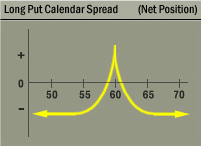Long Put Calendar Spread (Put Horizontal)
This strategy combines a longer-term bearish outlook with a near-term neutral/bullish outlook.
Description
To enter into a long put calendar spread, an investor sells one near-term put option and buys a second put option with a more distant expiration.The strategy most commonly involves puts with the same strike (horizontal spread), but can also be done with different strikes (diagonal spread).
Outlook
The investor is looking for either a steady to slightly rising stock price during the life of the near-term option and then a move lower during the life of the far-term option, or a sharp rise in implied volatility levels.
Summary
This strategy combines a longer-term bearish outlook with a near-term neutral/bullish outlook.
If the stock remains steady or rises during the life of the near-term option, it will expire worthless and leave the investor owning the longer-term option. If both options have the same strike price, the strategy will always require paying a premium to initiate the position.

EXAMPLE
- Short 1 XYZ near 60 put
- Long 1 XYZ far 60 put
MAXIMUM GAIN
- Strike price - net premium paid
MAXIMUM LOSS
-
Net premium paid
Motivation
The investor is hoping the sale of the near-term put offsets the cost of purchasing a longer-term put.
Variations
The strategy described here involves two puts with the same strike but a different expiration, i.e., a horizontal spread. A diagonal spread, involving two puts with different strikes as well as expirations, would have a slightly different profit/loss profile. The basic concepts, however, would continue to apply.
Max Loss
The maximum loss would occur should the two options reach parity. This could happen if the underlying stock rose enough that both options became worthless, or if the stock declined enough that both options went deep in-the-money and traded at their intrinsic value. In either case, the loss would be the premium paid to establish the position.
Max Gain
At the expiration of the near-term option, the maximum gain would occur should the underlying stock be at the strike price of the expiring option. If the stock were any lower the expiring option would have intrinsic value, and if the stock were any higher the longer-term option would have less value. Once the near-term option has expired worthless, the investor is left with simply a long put, whose potential profit is limited only because the stock cannot go below zero.
Profit/Loss
During the life of the near-term option, the potential profit is limited to the extent the near-term option declines in value more quickly than the longer-term option. Once the near-term option has expired, however, the strategy becomes simply a long put whose potential profit is substantial. The potential loss is limited to the premium paid to initiate the position.
Breakeven
Since the options differ in their time to expiration, the level where the strategy breaks even is a function of the underlying stock price, implied volatility and rates of time decay. Should the near-term option expire worthless, breakeven at the longer-term option's expiration would occur if the stock were below the strike price by the amount of the premium paid. But of course it could occur at any time should the position be closed out for a credit equal to the debit paid when the position was initiated.
Volatility
An increase in implied volatility, all other things equal, would have an extremely positive impact on this strategy. In general, longer-term options have a greater sensitivity to changes in market volatility, i.e., a higher Vega. Be aware, however, that the near and far-term options could and probably will trade at different implied volatility levels.
Time Decay
The passage of time, all other things equal, would have a positive impact on this strategy in the beginning. That changes, however, once the near-term option has expired and the strategy becomes simply a long put whose value will be eroded by the passage of time. In general, an option's rate of time decay increases as its expiration draws nearer.
Assignment Risk
Early assignment, while possible at any time, generally occurs for a put only when it goes deep-in-the-money. Should early exercise occur, using the longer-term option to cover the assignment would require financing a long stock position for one business day.
And be aware, a situation where a stock is involved in a restructuring or capitalization event, such as a merger, takeover, spin-off or special dividend, could completely upset typical expectations regarding early exercise of options on the stock.
Expiration Risk
Should the near-term put (the short side of the spread) be exercised when it expires, the longer-term put option would remain to provide a hedge. However, assignment on the near-term put would result in the investor entering into a long stock position.
If the longer-term put were held into expiration, it could be subject to auto-exercise if in-the-money.
Comments
The difference in time to expiration of these two put options results in their having a different Theta, Delta and Gamma. Obviously, the near-term put suffers more from time decay, i.e., has a higher Theta. While the near-term put may often have a lower Delta, its Gamma may be higher (if the strike is at-the-money). This means that if the stock moves sharply lower, the near-term put becomes much more sensitive to the stock price and its value approaches that of the more expensive longer-term put. A common variation of this strategy is to write another short-term option each time the previous one expires, until such time as the underlying stock moves significantly or the longer-term put approaches expiration.
Related Position
Comparable Position: N/A
Opposite Position: Short Put Calendar Spread

